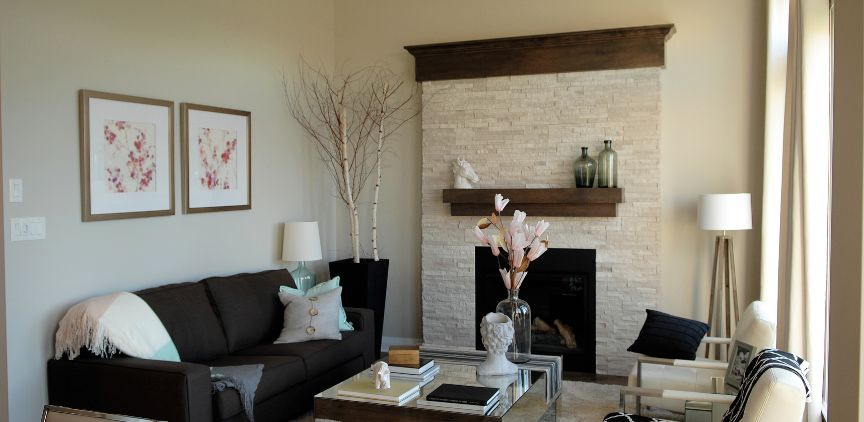Even Small Things Can Be Made to Look Big
Not all houses are blessed with spacious living rooms. Older homes especially tend to suffer from small living rooms as trends toward a more open-concept house have evolved throughout the decade. Fortunately, there are plenty of clever interior decorating ideas, tips, and tricks you can employ to visually expand your small living room, making it feel much roomier than it actually is.
Neutral Paint Colors
Paint is a terrific method of transforming a room. Dark colors enclose a room, making it feel cozy and warm. Neutral and softer colors invite light on a more reflective surface, visually opening up the room. You don’t have to avoid color when choosing the paint to make your small space bigger. So long as you’re thinking about the cohesive color scheme, whether you choose cool tones, like blues and greens, or warmer tones, like beige or terracotta, the space will feel larger by being less disjointed.
Keeping the ceiling a light paint color will also help make the living room seem larger. Small living rooms will feel less enclosed with bright, reflective overhead that prevents the room from seeming encroaching and constrictive.
Employ the Trickery of Mirrors
Mirror, mirror on the wall, how do you make the living room feel not so small? Every interior decorator will agree that mirrors make any room bigger. Mirrors create additional light by reflecting off the window, lamps, and glass, ricocheting light around the room (and light colors and sunshine expand rooms by creating openness).
But it’s not just reflecting light—a mirror’s purpose is to reflect images, which creates a visual illusion that tricks our minds into feeling the room is bigger than it actually is. Large decorative mirrors are statement pieces in small living rooms that will make the room look—and feel—bigger.
Related Search Topics (Ads)
Choose Tapered Furniture
The use of large, heavy furniture dwarfs living rooms. If you already have a small living room, furniture with thick, trunk-like feet, clunky frames, and marshmallow-sized cushions won’t do the space any favors. Instead, select furniture with delicate frames, tapered legs, and narrower builds.
Achieving the look of a larger living room will mean selecting pieces with thought. Smaller couches, end tables with spindle legs, skinny floor lamps, and skinnier living room chairs will contribute to expanding a small living room without sacrificing seating and other necessities. By paying close attention to the scale of your living room furniture, you can greatly expand the look and feel of the room.
Say Goodbye to Clutter
It doesn’t take a professional interior designer to recognize that clutter makes spaces become small and confining. Living rooms can quickly become small spaces with a lot of clutter, so take some time and go through items that can be donated, pitched, or stored. By asking yourself if you’ve used an item or really need it, you’ll be able to halve the unnecessary items in your living room while doubling the feel of its size.
Even if you don’t want to give away or pitch a thing, you can invest in furniture that tucks away things that don’t need to be out cluttering your already small space. Clean and clear surfaces and rooms automatically feel larger. Plus, who doesn’t like to get organized?
All About Lighting
To make a small living room look bigger, consider the lighting. As mentioned, lighting plays an immersive role in expanding small spaces. While natural light is usually preferred due to its psychological benefits, not all homeowners are blessed with large windows to usher in sunlight throughout the day. Lack of lighting in windows and lamps makes a room appear smaller, so being intentional about light-scaping can have a huge impact on the size of your space.
Lighting is key, and layering lighting will make a room feel much more sprawling than its size. Thinking in stages, plan for table lamps for cozy lighting, floor lamps as a brighter second stage, and ceiling lighting that make the small space feel tall and brightly illuminated when powered on. Even if your small living room gets plenty of natural sunlight, you’ll still want to layer lighting for nighttime to create a larger sense of space.
Be Mindful of Your Wall Art
It can be tempting to clutter walls with thousands of pictures. If that’s your prerogative, then by all means, clutter away! For those trying to expand a small space, consider choosing one large piece of art instead of creating a busy gallery wall.
Draw the focal point of the living room into one central piece of art. Part of this idea of sparse wall art is an appreciation of minimalism; the less clutter and business walls sport, the less the viewer’s eye dances around the room. Cutting down an overwhelming visual scene and lending to the theme of minimalism will graciously expand your small space into one that seems much larger.

